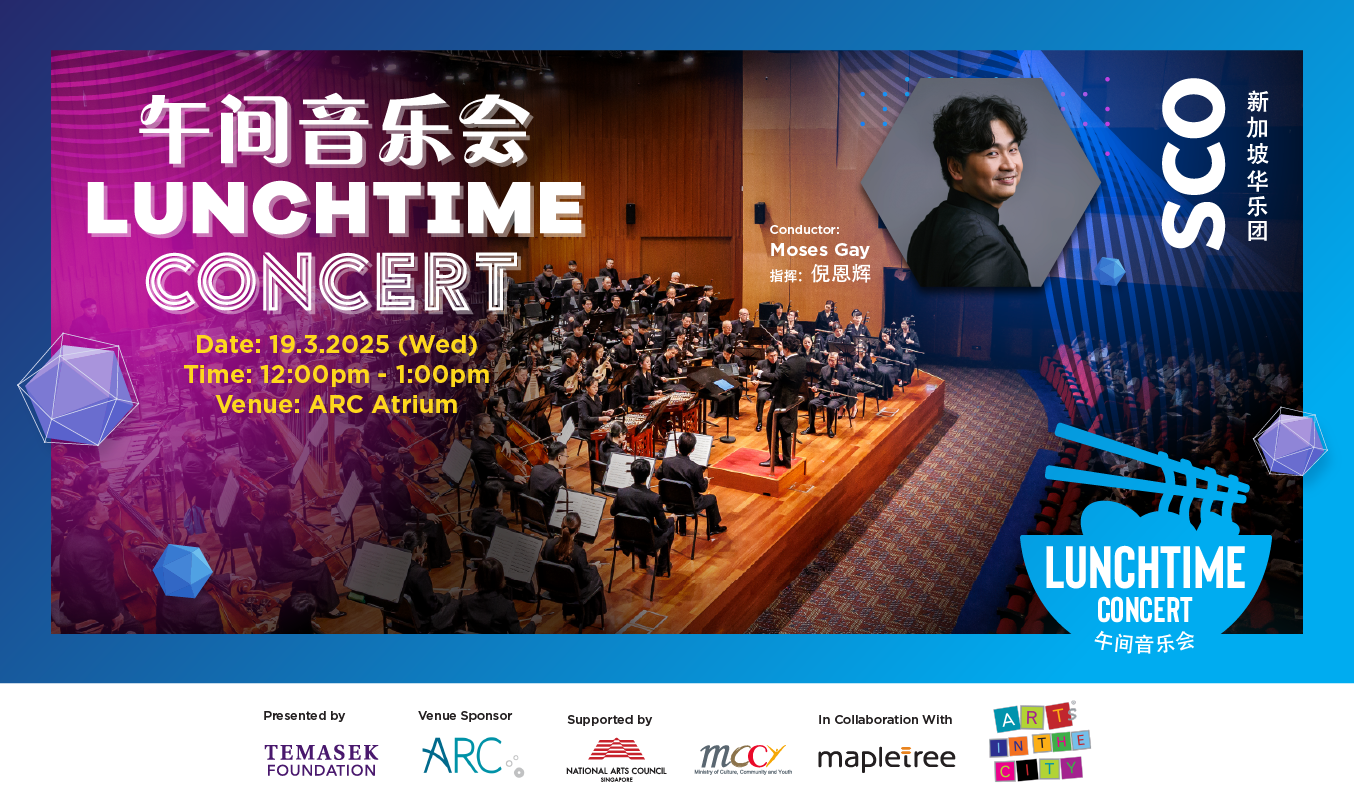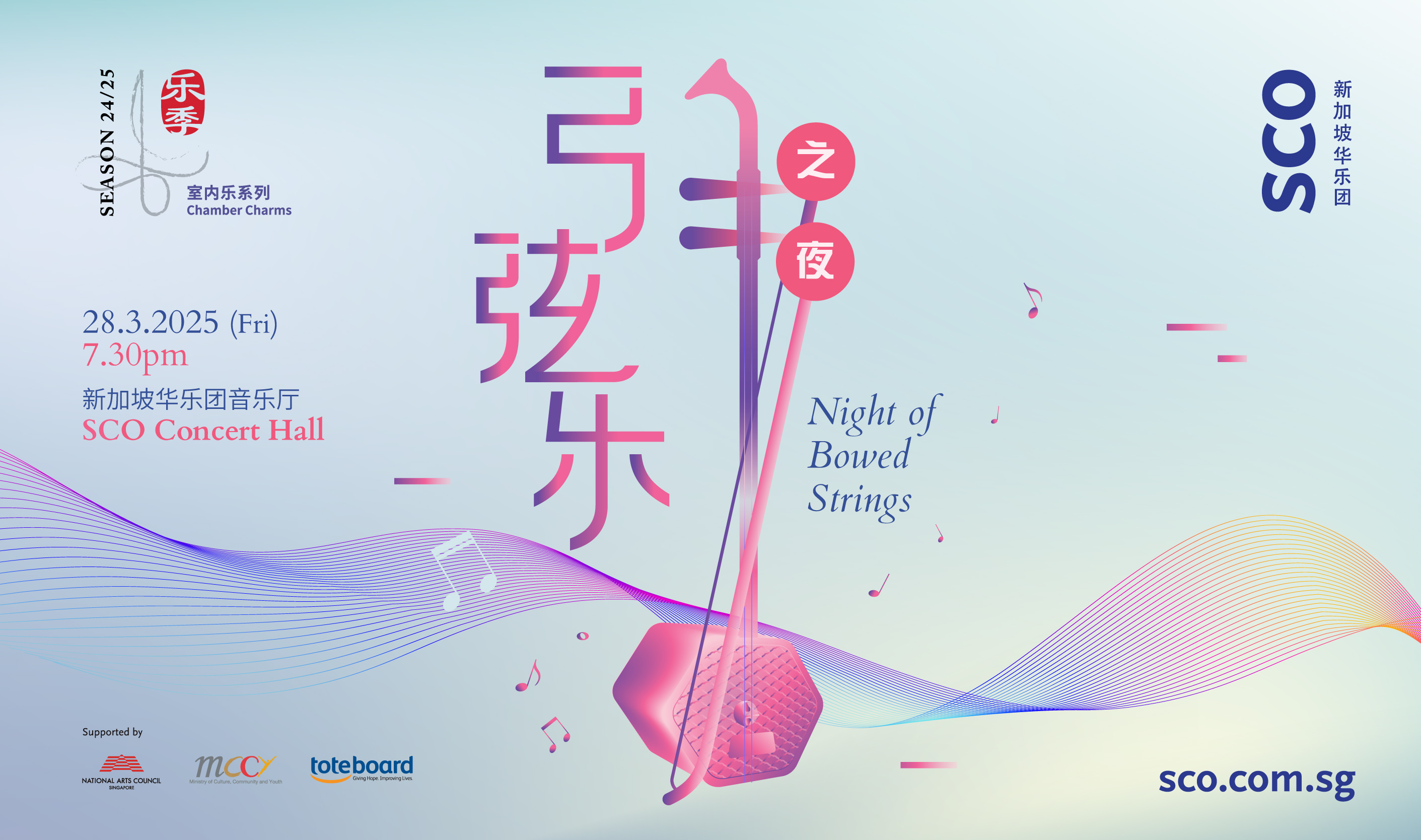Concert Season 24/25 | Chamber Charms 乐季24/25 | 室内乐系列
By Zhang Heyang
Chamber Charms: Night of Bowed-Strings is not merely a showcase of virtuosic string performance but a profound musical odyssey traversing regions, cultures and historical narratives. The programme features a meticulously curated array of instrumental configurations that ranges from intimate quartets to the full-bodied resonance of a bowed-string ensemble, and illuminates the multifaceted allure of string instruments. Spanning a diverse spectrum of regional musical idioms, these eight works reimagine traditional melodies through innovative orchestration while infusing them with renewed vitality. Be it evoking the rich tapestry of folk traditions or exploring the boundless possibilities of musical form, this concert is a testament to the curators' deep artistic vision and nuanced appreciation of the expressive breadth of bowed-string music.
Curated by SCO Concertmaster Li Baoshun under the artistic direction of Principal Conductor Quek Ling Kiong, these intricately interwoven works allow the bowed-strings to transcend roles beyond being mere instruments of sound. They emerge as eloquent narrators who articulate poignant farewells and heartfelt reunions, paint evocative landscapes, extol the valour of heroes and delicately weave tales of love and longing.
The concert opens with Merriment in Kazakhstan, a piece originally composed by Kuan Nai-Chung for the pipa and later reimagined for a bowed-string ensemble. With its exuberant and spirited melodies, the work vividly captures the fluid, dynamic movements of Kazakh dance. Through the delicate imitation of the dombra’s plucked timbre, the music infuses the concert hall with an enchanting rhythm, evoking the vibrant essence of a distant land.
Red Maples on the Autumn Ridge is one of the few erhu compositions by Jin Fuzai and serves as a companion piece to his erhu concerto, Spring River’s Warming. The two works echo each other in musical material and sentiment, both embody an elegant, refined style with poetic beauty. In this arrangement for the huqin quartet, the interplay of four huqin voices enriches the work’s textural depth and brings greater dimension to the imagery of crimson maple leaves blanketing the autumn mountains.
Playing the Flower Drum is the first movement of Xiang Yun, a Huagu Opera Play that draws inspiration from Hunan’s vibrant Huagu Opera. Through the interplay of four huqin instruments, the piece artfully emulates the theatrical exchanges between stage characters. With its crisp, rhythmic vitality and ingenious percussive imitations, the composition brims with energy and renders the music vividly expressive, while showcasing the rich tonal possibilities of bowed-string instruments.
In the works Desiring Intimacy and Through the Western Pass, the profound and evocative emotions of Shanxi folk songs are poignantly conveyed. Desiring Intimacy has been reimagined by SCO gaohu musician Liu Zhiyue for cello and bass, deepening its sonorous richness and amplifying its emotive power. Meanwhile, Through the Western Pass is steeped in the Shanxi folk tradition and finds new life through the orchestration by local composer Sim Boon Yew. This plaintive ballad of parting and yearning unfolds through the delicate weave of bowed strings, where sorrow and tenderness intertwine in a deeply expressive, poetic lament.
Beyond the rich regional character, many of these works are imbued with vivid imagery while also exploring innovative approaches to instrumentation.
Chen Yunyun’s Red Velvet was originally composed as a duet for erhu and zhonghu, with yangqin accompaniment, inspired by the striking contrasts of colour and texture found in the red velvet cake. For this concert, the instrumentation has been expanded to enhance the richness and depth of the bowed-string ensemble. The piece unfolds with elegantly flowing melodies, suffused with wistful emotion, while its fast-paced sections drive forward with vibrant rhythmic energy. Seamlessly shifting between delicacy and intensity, the work crafts a sensory experience through its expressive textures and evocative contrasts.
Music does more than reflect the world around us, it carries the weight and depth of history. The latter part of this concert delves into the powerful theme of heroes. Composed by Joshua Chan to commemorate the 70th anniversary of China’s National Day, Huai Song is a string work that pays tribute to the spirit of heroism through its lush harmonies and fluid melodic lines. Its intricate contrapuntal textures evoke the passage of history, while its bright, uplifting rhythms convey a hopeful vision for the future.
The grand finale of the concert, Yellow River Capriccio, Movement IV: Defending the Yellow River, was adapted by Yang Chunlin from Xian Xinghai’s monumental Yellow River Cantata for a bowed-string ensemble. A work of immense intensity and passion, this arrangement preserves the original’s sweeping grandeur while recalibrating the orchestration to highlight the distinctive balance of strength and suppleness of the bowed-string instruments. With its soaring melodies and surging rhythms, the piece builds a magnificent musical panorama, bringing the concert to a resounding and exhilarating conclusion.
文/ 张鹤杨
“弓弦乐之夜” 不仅是一场高水准的弦乐飨宴,也是一次跨越地域、文化与历史的音乐探索。整场音乐会以多样的编配手法,从小重奏到全体弓弦乐声部的合奏,充分展现弓弦乐的独特魅力。八部作品既涵盖了不同地域的音乐风格,也通过创新编配,使传统旋律焕发新生。无论是地域风情的描绘,还是音乐形式的多样化展现,都体现出策划者对弓弦音乐表现力的深度挖掘。
在新加坡华乐团首席李宝顺的策划与首席指挥郭勇德的艺术指导下,这些作品被巧妙编织在一起,让弓弦不仅是发声的工具,更是讲述故事的媒介。它们诉说离愁别绪,也描绘山水风光;它们吟诵英雄往事,也编织温柔浪漫的诗篇。
音乐会的开场曲《热舞哈萨克》是作曲家关迺忠最早为琵琶创作的作品,后经改编为弓弦乐合奏。作品以热情奔放的旋律,再现了哈萨克族舞蹈的流动感,并通过模仿“冬不拉”弹拨声,使音乐厅充满异域风情的律动感。
《秋岭枫红》是作曲家金复载为二胡创作的少数作品之一,也是其二胡协奏曲《春江水暖》的姐妹篇。两部作品在音乐内容和素材上相互呼应,均展现出清秀典雅、富有诗意的风格。这次《秋岭枫红》被改编为胡琴四重奏,通过四把胡琴交错演绎,赋予作品更丰富的层次感,也使秋日红叶漫山的画面更加立体。
《湘韵》第一乐章《戏花鼓》则取材于湖南花鼓戏,通过四把胡琴之间的互动,模拟当地戏曲中的角色对话。作品节奏鲜明,活力十足,并巧妙地模仿打击乐,使音乐更加生动,展现了弓弦乐器的丰富音响效果。
在《想亲亲》和《走西口》中,我们听到山西民歌深沉而动人的表达。《想亲亲》是一首旋律辨识度极高的山西民歌,这次由新加坡华乐团高胡演奏家刘智乐专为大提琴和低音提亲声部改编,使其音色更加饱满深邃,情感更为浓烈。而《走西口》采用山西小调的旋律,在本地作曲家沈文友的编配下,使这首诉说生离死别的民间小调,在弦乐交织中展现出哀而不伤的情绪波澜。
除了地域风情,许多作品也在音乐中融入了丰富的意象,并在编制上进行了独特的探索。
陈芸芸的《红丝绒》原是二胡与中胡的双胡琴作品,扬琴伴奏,以红丝绒蛋糕的色彩对比与口感意象为灵感。此次音乐会的编制进一步扩展,使弓弦乐的音响厚度更加饱满。作品旋律线条优美流畅,忧郁而深情,而快板部分则借助富有动感的节奏,使整部作品在温柔与激情之间游走自如,画面感极强。
音乐不仅描绘现实世界,也承载着历史的沉思与民族情怀。本场音乐会的后半部分则聚焦于这一主题。《怀颂》是作曲家陈锦标为中国国庆七十周年特别创作的弦乐作品,借由饱满的和声与流畅的旋律线条,展现英雄的主题。作品在层层交织的对位结构中展现历史变迁,同时也在光明昂扬的节奏中表达对未来的期许。
音乐会的压轴之作《黄河随想》第四乐章《保卫黄河》,取材自冼星海的《黄河大合唱》,由杨春林改编为民族拉弦乐合奏。这是一首极富张力与激情的作品,改编者在调整弦乐编配的同时,保留了原作的磅礴气势,并展现出弦乐器柔中带刚的独特表现力。激昂的旋律、澎湃的节奏,构筑起壮丽的音乐画卷,为整场音乐会画下最振奋人心的句点。



